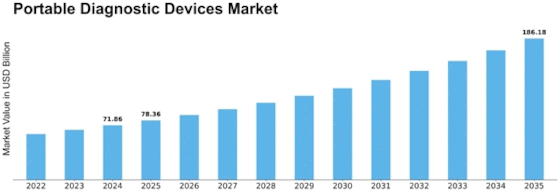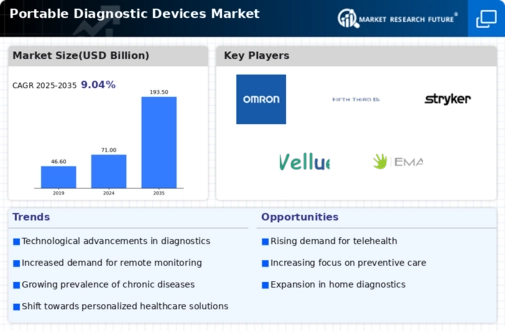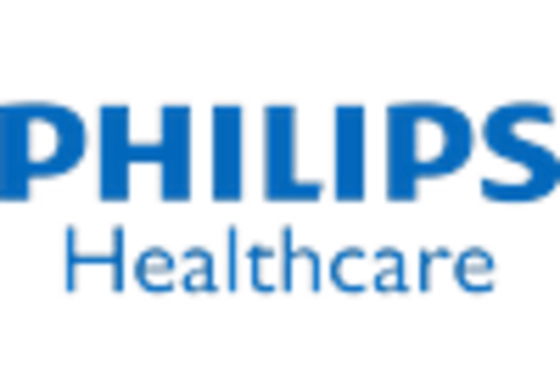-
EXECUTIVE SUMMARY
-
OVERVIEW
-
MARKET INTRODUCTION
-
DEFINITION
-
SCOPE OF THE STUDY
-
RESEARCH OBJECTIVE
-
MARKET STRUCTURE
-
ASSUMPTIONS & LIMITATIONS
-
RESEARCH METHODOLOGY
-
DATA MINING
-
SECONDARY RESEARCH
-
PRIMARY RESEARCH
-
BREAKDOWN OF PRIMARY RESPONDENTS
-
FORECASTING TECHNIQUES
-
RESEARCH METHODOLOGY FOR MARKET SIZE ESTIMATION
- BOTTOM-UP APPROACH
- TOP-DOWN APPROACH
-
DATA TRIANGULATION
-
VALIDATION
-
MARKET DYNAMICS
-
OVERVIEW
-
DRIVERS
- GROWING TECHNOLOGICAL ADVANCEMENTS
- INCREASING INCIDENCES OF CHRONIC DISEASES
-
RESTRAINTS
- LACK OF KNOWLEDGE TO RUN PORTABLE DIAGNOSTIC DEVICES IS A HINDRANCE TO THE MARKET
-
OPPORTUNITIES
- INCREASING FUNDING AND INVESTMENT THROUGH A PUBLIC AND PRIVATE ORGANIZATIONS
-
MARKET FACTOR ANALYSIS
-
VALUE CHAIN ANALYSIS
- R&D & DESIGNING
- MANUFACTURING
- DISTRIBUTION & SALES
- POST-SALES MONITORING
-
PORTER''S FIVE FORCES MODEL
- THREAT OF NEW ENTRANTS
- BARGAINING POWER OF SUPPLIERS
- THREAT OF SUBSTITUTES
- BARGAINING POWER OF BUYERS
- INTENSITY OF RIVALRY
-
IMPACT OF COVID-19 ON THE GLOBAL PORTABLE DIAGNOSTIC DEVICES MARKET
- IMPACT ON SUPPLY CHAIN
- IMPACT ON PRODUCTION
- IMPACT ON REGIONS
- IMPACT ON SUPPLY GAP ANALYSIS
- IMPACT ON PRICING
-
GLOBAL PORTABLE DIAGNOSTIC DEVICES MARKET, BY TYPE
-
OVERVIEW
-
DIAGNOSTIC IMAGING
- CT Scan
- X-Ray
- Ultrasound
- Endoscopes
-
MONITORING DEVICES
- Cardiac Monitoring
- Neuromonitoring
- Respiratory Monitoring
- Ophthalmic Monitoring
- Hemodynamic Monitoring Systems
- Vital Sign Monitors
- Smart Wearable Medical Device
- Others
-
GLOBAL PORTABLE DIAGNOSTIC DEVICES MARKET, BY APPLICATION
-
OVERVIEW
-
GYNAECOLOGY
-
CARDIOLOGY
-
GASTROINTESTINAL
-
UROLOGY
-
NEUROLOGY
-
RESPIRATORY
-
ORTHOPEDICS
-
OPTHALMOLOGY
-
OTHERS
-
GLOBAL PORTABLE DIAGNOSTIC DEVICES MARKET, BY END USER
-
OVERVIEW
-
HOSPITALS & CLINICS
-
DIAGNOSTIC CENTERS
-
HOMECARE SETTINGS
-
OTHERS
-
GLOBAL PORTABLE DIAGNOSTIC DEVICES MARKET, BY REGION
-
OVERVIEW
-
GLOBAL
-
NORTH AMERICA
- US
- CANADA
-
EUROPE
- GERMANY
- UK
- FRANCE
- ITALY
- SPAIN
- REST OF EUROPE
-
ASIA-PACIFIC
- CHINA
- INDIA
- JAPAN
- AUSTRALIA
- SOUTH KOREA
- REST OF ASIA-PACIFIC
-
REST OF THE WORLD
- MIDDLE EAST
- AFRICA
- LATIN AMERICA
-
COMPETITIVE LANDSCAPE
-
OVERVIEW
-
COMPETITIVE BENCHMARKING
-
MAJOR GROWTH STRATEGY IN THE GLOBAL PORTABLE DIAGNOSTIC DEVICES MARKET
-
THE LEADING PLAYER IN TERMS OF THE NUMBER OF DEVELOPMENTS IN THE GLOBAL PORTABLE DIAGNOSTIC DEVICES MARKET
-
KEY DEVELOPMENT ANALYSIS
-
KEY DEVELOPMENTS & GROWTH STRATEGIES
- PRODUCT LAUNCH/PRODUCT APPROVAL
- PARTNERSHIP/ AGREEMENT/COLLABORATION
-
MAJOR PLAYERS SALES ANALYSIS
- SALES & OPERATING INCOME
-
MAJOR PLAYERS R&D ANALYSIS
-
COMPANY PROFILE
-
F. HOFFMANN-LA ROCHE LTD
- COMPANY OVERVIEW
- FINANCIAL OVERVIEW
- PRODUCTS OFFERED
- KEY DEVELOPMENTS
- KEY STRATEGIES
-
GE HEALTHCARE
- COMPANY OVERVIEW
- FINANCIAL OVERVIEW
- PRODUCTS OFFERED
- KEY DEVELOPMENTS
- SWOT ANALYSIS
- KEY STRATEGIES
-
MEDTRONIC
- COMPANY OVERVIEW
- FINANCIAL OVERVIEW
- PRODUCTS OFFERED
- KEY DEVELOPMENTS
- SWOT ANALYSIS
- KEY STRATEGIES
-
OMRON HEALTHCARE, INC.
- COMPANY OVERVIEW
- FINANCIAL OVERVIEW
- PRODUCTS OFFERED
- KEY DEVELOPMENTS
- KEY STRATEGIES
-
KONINKLIJKE PHILIPS N.V.
- COMPANY OVERVIEW
- FINANCIAL OVERVIEW
- PRODUCTS OFFERED
- KEY DEVELOPMENTS
- SWOT ANALYSIS
- KEY STRATEGIES
-
ABBOTT
- COMPANY OVERVIEW
- FINANCIAL OVERVIEW
- PRODUCTS OFFERED
- KEY DEVELOPMENTS
- SWOT ANALYSIS
- KEY STRATEGIES
-
SAMSUNGHEALTHCARE.COM
- COMPANY OVERVIEW
- FINANCIAL OVERVIEW
- PRODUCTS OFFERED
- KEY DEVELOPMENTS
- KEY STRATEGIES
-
STRYKER
- COMPANY OVERVIEW
- FINANCIAL OVERVIEW
- PRODUCTS OFFERED
- KEY DEVELOPMENTS
- KEY STRATEGIES
-
WELLUE
- COMPANY OVERVIEW
- FINANCIAL OVERVIEW
- PRODUCTS OFFERED
- KEY DEVELOPMENTS
- KEY STRATEGIES
-
EMAY
- COMPANY OVERVIEW
- FINANCIAL OVERVIEW
- PRODUCTS OFFERED
- KEY DEVELOPMENTS
- KEY STRATEGIES
-
-
LIST OF TABLES
-
LIST OF ASSUMPTIONS & LIMITATIONS
-
PRIMARY INTERVIEWS AND INFORMATION GATHERING PROCESS
-
GLOBAL PORTABLE DIAGNOSTIC DEVICES MARKET, BY TYPE, 2019–2032 (USD MILLION)
-
GLOBAL PORTABLE DIAGNOSTIC DEVICES MARKET, FOR DIAGNOSTIC IMAGING, BY REGION, 2019–2032 (USD MILLION)
-
GLOBAL PORTABLE DIAGNOSTIC DEVICES MARKET, FOR DIAGNOSTIC IMAGING, BY TYPE, 2019–2032 (USD MILLION)
-
GLOBAL PORTABLE DIAGNOSTIC DEVICES MARKET, FOR MONITORING DEVICES, BY REGION, 2019–2032 (USD MILLION)
-
GLOBAL PORTABLE DIAGNOSTIC DEVICES MARKET, FOR MONITORING DEVICES, BY TYPE, 2019–2032 (USD MILLION)
-
GLOBAL PORTABLE DIAGNOSTIC DEVICES MARKET, FOR CARDIAC MONITORING, BY TYPE, 2019–2032 (USD MILLION)
-
GLOBAL PORTABLE DIAGNOSTIC DEVICES MARKET, FOR NEUROMONITORING, BY TYPE, 2019–2032 (USD MILLION)
-
GLOBAL PORTABLE DIAGNOSTIC DEVICES MARKET, FOR RESPIRATORY MONITORING, BY TYPE, 2019–2032 (USD MILLION)
-
GLOBAL PORTABLE DIAGNOSTIC DEVICES MARKET, FOR OPTHALMIC MONITORING, BY TYPE, 2019–2032 (USD MILLION)
-
GLOBAL PORTABLE DIAGNOSTIC DEVICES MARKET, BY APPLICATION, 2019–2032 (USD MILLION)
-
GLOBAL PORTABLE DIAGNOSTIC DEVICES MARKET, FOR GYNAECOLOGY, BY REGION, 2019–2032 (USD MILLION)
-
GLOBAL PORTABLE DIAGNOSTIC DEVICES MARKET, FOR CARDIOLOGY, BY REGION, 2019–2032 (USD MILLION)
-
GLOBAL PORTABLE DIAGNOSTIC DEVICES MARKET, FOR GASTROINTESTINAL, BY REGION, 2019–2032 (USD MILLION)
-
GLOBAL PORTABLE DIAGNOSTIC DEVICES MARKET, FOR UROLOGY, BY REGION, 2019–2032 (USD MILLION)
-
GLOBAL PORTABLE DIAGNOSTIC DEVICES MARKET, FOR NEUROLOGY, BY REGION, 2019–2032 (USD MILLION)
-
GLOBAL PORTABLE DIAGNOSTIC DEVICES MARKET, FOR RESPIRATORY, BY REGION, 2019–2032 (USD MILLION)
-
GLOBAL PORTABLE DIAGNOSTIC DEVICES MARKET, FOR ORTHOPEDICS, BY REGION, 2019–2032 (USD MILLION)
-
GLOBAL PORTABLE DIAGNOSTIC DEVICES MARKET, FOR OPTHALMOLOGY, BY REGION, 2019–2032 (USD MILLION)
-
GLOBAL PORTABLE DIAGNOSTIC DEVICES MARKET, FOR OTHERS, BY REGION, 2019–2032 (USD MILLION)
-
GLOBAL PORTABLE DIAGNOSTIC DEVICES MARKET, FOR BY END USER, 2019–2032 (USD MILLION)
-
GLOBAL PORTABLE DIAGNOSTIC DEVICES MARKET, FOR HOSPITALS & CLINICS, BY REGION 2019–2032 (USD MILLION)
-
GLOBAL PORTABLE DIAGNOSTIC DEVICES MARKET, FOR DIAGNOSTIC CENTERS, BY REGION, 2019–2032 (USD MILLION)
-
GLOBAL PORTABLE DIAGNOSTIC DEVICES MARKET, FOR HOMECARE SETTINGS, BY REGION, 2019–2032 (USD MILLION)
-
GLOBAL PORTABLE DIAGNOSTIC DEVICES MARKET, FOR OTHERS, BY REGION, 2019–2032 (USD MILLION)
-
GLOBAL PORTABLE DIAGNOSTIC DEVICES MARKET, BY REGION, 2019–2032 (USD MILLION)
-
GLOBAL PORTABLE DIAGNOSTIC DEVICES MARKET, BY TYPE, 2019–2032 (USD MILLION)
-
GLOBAL PORTABLE DIAGNOSTIC DEVICES MARKET, FOR DIAGNOSTIC IMAGING, BY TYPE, 2019–2032 (USD MILLION)
-
GLOBAL PORTABLE DIAGNOSTIC DEVICES MARKET, FOR MONITORING DEVICES, BY TYPE, 2019–2032 (USD MILLION)
-
GLOBAL PORTABLE DIAGNOSTIC DEVICES MARKET, FOR CARDIAC MONITORING, BY TYPE, 2019–2032 (USD MILLION)
-
GLOBAL PORTABLE DIAGNOSTIC DEVICES MARKET, FOR NEUROMONITORING, BY TYPE, 2019–2032 (USD MILLION)
-
GLOBAL PORTABLE DIAGNOSTIC DEVICES MARKET, FOR RESPIRATORY MONITORING, BY TYPE, 2019–2032 (USD MILLION)
-
GLOBAL PORTABLE DIAGNOSTIC DEVICES MARKET, FOR OPTHALMIC MONITORING, BY TYPE, 2019–2032 (USD MILLION)
-
GLOBAL PORTABLE DIAGNOSTIC DEVICES MARKET, BY APPLICATION, 2019–2032 (USD MILLION)
-
GLOBAL PORTABLE DIAGNOSTIC DEVICES MARKET, BY END USER, 2019–2032 (USD MILLION)
-
NORTH AMERICA: PORTABLE DIAGNOSTIC DEVICES MARKET, BY COUNTRY, 2019–2032 (USD MILLION)
-
NORTH AMERICA: PORTABLE DIAGNOSTIC DEVICES MARKET, BY TYPE, 2019–2032 (USD MILLION)
-
NORTH AMERICA: PORTABLE DIAGNOSTIC DEVICES MARKET, FOR DIAGNOSTIC IMAGING, BY TYPE, 2019–2032 (USD MILLION)
-
NORTH AMERICA: PORTABLE DIAGNOSTIC DEVICES MARKET, FOR MONITORING DEVICES, BY TYPE, 2019–2032 (USD MILLION)
-
NORTH AMERICA: PORTABLE DIAGNOSTIC DEVICES MARKET, FOR CARDIAC MONITORING, BY TYPE, 2019–2032 (USD MILLION)
-
NORTH AMERICA: PORTABLE DIAGNOSTIC DEVICES MARKET, FOR NEUROMONITORING, BY TYPE, 2019–2032 (USD MILLION)
-
NORTH AMERICA: PORTABLE DIAGNOSTIC DEVICES MARKET, FOR RESPIRATORY MONITORING, BY TYPE, 2019–2032 (USD MILLION)
-
NORTH AMERICA: PORTABLE DIAGNOSTIC DEVICES MARKET, FOR OPTHALMIC MONITORING, BY TYPE, 2019–2032 (USD MILLION)
-
NORTH AMERICA: PORTABLE DIAGNOSTIC DEVICES MARKET, BY APPLICATION, 2019–2032 (USD MILLION)
-
NORTH AMERICA: PORTABLE DIAGNOSTIC DEVICES MARKET, BY END USER AMERICAER, 2019–2032 (USD MILLION)
-
US: PORTABLE DIAGNOSTIC DEVICES MARKET, BY TYPE, 2019–2032 (USD MILLION)
-
US: PORTABLE DIAGNOSTIC DEVICES MARKET, FOR DIAGNOSTIC IMAGING, BY TYPE, 2019–2032 (USD MILLION)
-
US: PORTABLE DIAGNOSTIC DEVICES MARKET, FOR MONITORING DEVICES, BY TYPE, 2019–2032 (USD MILLION)
-
US: PORTABLE DIAGNOSTIC DEVICES MARKET, FOR CARDIAC MONITORING, BY TYPE, 2019–2032 (USD MILLION)
-
US: PORTABLE DIAGNOSTIC DEVICES MARKET, FOR NEUROMONITORING, BY TYPE, 2019–2032 (USD MILLION)
-
US: PORTABLE DIAGNOSTIC DEVICES MARKET, FOR RESPIRATORY MONITORING, BY TYPE, 2019–2032 (USD MILLION)
-
US: PORTABLE DIAGNOSTIC DEVICES MARKET, FOR OPTHALMIC MONITORING, BY TYPE, 2019–2032 (USD MILLION)
-
US: PORTABLE DIAGNOSTIC DEVICES MARKET, BY APPLICATION, 2019–2032 (USD MILLION)
-
US: PORTABLE DIAGNOSTIC DEVICES MARKET, BY END USER, 2019–2032 (USD MILLION)
-
CANADA: PORTABLE DIAGNOSTIC DEVICES MARKET, BY TYPE, 2019–2032 (USD MILLION)
-
CANADA: PORTABLE DIAGNOSTIC DEVICES MARKET, FOR DIAGNOSTIC IMAGING, BY TYPE, 2019–2032 (USD MILLION)
-
CANADA: PORTABLE DIAGNOSTIC DEVICES MARKET, FOR MONITORING DEVICES, BY TYPE, 2019–2032 (USD MILLION)
-
CANADA: PORTABLE DIAGNOSTIC DEVICES MARKET, FOR CARDIAC MONITORING, BY TYPE, 2019–2032 (USD MILLION)
-
CANADA: PORTABLE DIAGNOSTIC DEVICES MARKET, FOR NEUROMONITORING, BY TYPE, 2019–2032 (USD MILLION)
-
CANADA: PORTABLE DIAGNOSTIC DEVICES MARKET, FOR RESPIRATORY MONITORING, BY TYPE, 2019–2032 (USD MILLION)
-
CANADA: PORTABLE DIAGNOSTIC DEVICES MARKET, FOR OPTHALMIC MONITORING, BY TYPE, 2019–2032 (USD MILLION)
-
CANADA: PORTABLE DIAGNOSTIC DEVICES MARKET, BY APPLICATION, 2019–2032 (USD MILLION)
-
CANADA: PORTABLE DIAGNOSTIC DEVICES MARKET, BY END USER, 2019–2032 (USD MILLION)
-
EUROPE: PORTABLE DIAGNOSTIC DEVICES MARKET, BY COUNTRY, 2019–2032 (USD MILLION)
-
EUROPE: PORTABLE DIAGNOSTIC DEVICES MARKET, BY TYPE, 2019–2032 (USD MILLION)
-
EUROPE: PORTABLE DIAGNOSTIC DEVICES MARKET, FOR DIAGNOSTIC IMAGING, BY TYPE, 2019–2032 (USD MILLION)
-
EUROPE: PORTABLE DIAGNOSTIC DEVICES MARKET, FOR MONITORING DEVICES, BY TYPE, 2019–2032 (USD MILLION)
-
EUROPE: PORTABLE DIAGNOSTIC DEVICES MARKET, FOR CARDIAC MONITORING, BY TYPE, 2019–2032 (USD MILLION)
-
EUROPE: PORTABLE DIAGNOSTIC DEVICES MARKET, FOR NEUROMONITORING, BY TYPE, 2019–2032 (USD MILLION)
-
EUROPE: PORTABLE DIAGNOSTIC DEVICES MARKET, FOR RESPIRATORY MONITORING, BY TYPE, 2019–2032 (USD MILLION)
-
EUROPE: PORTABLE DIAGNOSTIC DEVICES MARKET, FOR OPTHALMIC MONITORING, BY TYPE, 2019–2032 (USD MILLION)
-
EUROPE: PORTABLE DIAGNOSTIC DEVICES MARKET, BY APPLICATION, 2019–2032 (USD MILLION)
-
EUROPE: PORTABLE DIAGNOSTIC DEVICES MARKET, BY END USER AMERICAER, 2019–2032 (USD MILLION)
-
GERMANY: PORTABLE DIAGNOSTIC DEVICES MARKET, BY TYPE, 2019–2032 (USD MILLION)
-
GERMANY: PORTABLE DIAGNOSTIC DEVICES MARKET, FOR DIAGNOSTIC IMAGING, BY TYPE, 2019–2032 (USD MILLION)
-
GERMANY: PORTABLE DIAGNOSTIC DEVICES MARKET, FOR MONITORING DEVICES, BY TYPE, 2019–2032 (USD MILLION)
-
GERMANY: PORTABLE DIAGNOSTIC DEVICES MARKET, FOR CARDIAC MONITORING, BY TYPE, 2019–2032 (USD MILLION)
-
GERMANY: PORTABLE DIAGNOSTIC DEVICES MARKET, FOR NEUROMONITORING, BY TYPE, 2019–2032 (USD MILLION)
-










Leave a Comment